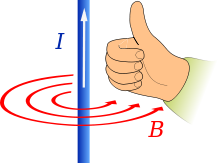Right-hand rule


In mathematics and physics, the right-hand rule is a common mnemonic for understanding notation conventions for vectors in 3 dimensions. It was invented for use in electromagnetism by British physicist John Ambrose Fleming in the late 19th century.[1][2]
When choosing three vectors that must be at right angles to each other, there are two distinct solutions, so when expressing this idea in mathematics, one must remove the ambiguity of which solution is meant.
There are variations on the mnemonic depending on context, but all variations are related to the one idea of choosing a convention.
The right-handed screw
Curl the fingers of your right hand around a screw with your thumb pointing towards the tip of the screw, and turn it in the direction of your fingers. If it moves in the direction of your thumb the screw is right-handed. Most screws are right-handed. Control knobs can be either right-handed or left-handed (Think of turning on a radio.). 'Clockwise' can be considered right-handed if your thumb points toward the clock or left-handed if your thumb points away from the clock.
Right-handed and Left-handed Co-ordinates
Let the X and Y axes define a horizontal plane with the X-axis pointing toward you. Then the Z-axis can either point up (right-handed) or down (left-handed). If the co-ordinates are right-handed and you place your right fist on the plane then your fingers will curl from the first or X-axis to the second or Y-axis and your thumb will point along the Z-axis. If the co-ordinates were left handed the fingers of your left hand would curl from the first axis to the second and your left thumb would point along the Z-axis.
If any one axis is reversed the handedness changes. To preserve handedness one of the other axes must also reverse which is equivalent to switching the labels on the other two axes. Note that the handedness of co-ordinates has no meaning unless the axes are labled in sequence: 1,2,3 or x,y,z.
Direction associated with an ordered pair of directions
One form of the right-hand rule is used in situations in which an ordered operation must be performed on two vectors a and b that has a result which is a vector c perpendicular to both a and b. The most common example is the vector cross product. The right-hand rule imposes the following procedure for choosing one of the two directions.
- With the thumb, index, and middle fingers at right angles to each other (with the index finger pointed straight), the middle finger points in the direction of c when the thumb represents a and the index finger represents b.
Other (equivalent) finger assignments are possible. For example, the first (index) finger can represent a, the first vector in the product; the second (middle) finger, b, the second vector; and the thumb, c, the product.[3]
Direction associated with a rotation


A different form of the right-hand rule, sometimes called the right-hand grip rule or the corkscrew-rule or the right-hand thumb rule, is used in situations where a vector must be assigned to the rotation of a body, a magnetic field or a fluid. Alternatively, when a rotation is specified by a vector, and it is necessary to understand the way in which the rotation occurs, the right-hand grip rule is applicable.
This version of the rule is used in two complementary applications of Ampère's circuital law:
- An electric current passes through a solenoid, resulting in a magnetic field. When you wrap your right hand around the solenoid with your fingers in the direction of the conventional current, your thumb points in the direction of the magnetic north pole.
- An electric current passes through a straight wire. Here, the thumb points in the direction of the conventional current (from positive to negative), and the fingers point in the direction of the magnetic lines of flux.
The principle is also used to determine the direction of the torque vector. If you grip the imaginary axis of rotation of the rotational force so that your fingers point in the direction of the force, then the extended thumb points in the direction of the torque vector.
The right-hand grip rule is a convention derived from the right-hand rule convention for vectors. When applying the rule to current in a straight wire for example, the direction of the magnetic field (counterclockwise instead of clockwise when viewed from the tip of the thumb) is a result of this convention and not an underlying physical phenomenon.
Applications
The first form of the rule is used to determine the direction of the cross product of two vectors. This leads to widespread use in physics, wherever the cross product occurs. A list of physical quantities whose directions are related by the right-hand rule is given below. (Some of these are related only indirectly to cross products, and use the second form.)
- The angular velocity of a rotating object and the rotational velocity of any point on the object
- A torque, the force that causes it, and the position of the point of application of the force
- A magnetic field, the position of the point where it is determined, and the electric current (or change in electric flux) that causes it
- A magnetic field in a coil of wire and the electric current in the wire
- The force of a magnetic field on a charged particle, the magnetic field itself, and the velocity of the object
- The vorticity at any point in the field of flow of a fluid
- The induced current from motion in a magnetic field (known as Fleming's right-hand rule)
- The x, y and z unit vectors in a Cartesian coordinate system can be chosen to follow the right-hand rule. Right-handed coordinate systems are often used in rigid body physics and kinematics.
Fleming's left-hand rule is a rule for finding the direction of the thrust on a conductor carrying a current in a magnetic field.

Left-hand rule
In certain situations, it may be useful to use the opposite convention, where one of the vectors is reversed and so creates a left-handed triad instead of a right-handed triad.
An example of this situation is for left-handed materials. Normally, for an electromagnetic wave, the electric and magnetic fields, and the direction of propagation of the wave obey the right-hand rule. However, left-handed materials have special properties, notably the negative refractive index. It makes the direction of propagation point in the opposite direction.
De Graaf's translation of Fleming's left-hand rule - which uses thrust, field and current - and the right-hand rule, is the FBI rule. The FBI rule changes thrust into F (Lorentz force), B (direction of the magnetic field) and I (current). The FBI rule is easily remembered by US citizens because of the commonly known abbreviation for the Federal Bureau of Investigation.
Symmetry
| Vector | Right-hand | Right-hand | Right-hand | Left-hand | Left-hand | Left-Hand |
|---|---|---|---|---|---|---|
| a, x or I | Thumb | Fingers or palm | First or Index | Thumb | Fingers or palm | First or index |
| b, y or B | First or index | Thumb | Fingers or palm | Fingers or palm | First or index | Thumb |
| c, z or F | Fingers or palm | First or index | Thumb | First or index | Thumb | Fingers or palm |
See also
- Chirality (mathematics)
- Curl (mathematics)
- Pseudovector
- Improper rotation
- Reflection (mathematics)
- Fleming's left-hand rule for motors
- Vorticity
- ISO 2
Notes
- ^ Fleming, John Ambrose (1902). Magnets and Electric Currents, 2nd Edition. London: E.& F. N. Spon. pp. 173–174.
{{cite book}}: Cite has empty unknown parameter:|coauthors=(help) - ^ "Right and left hand rules". Tutorials, Magnet Lab U. National High Magnetic Field Laboratory. Retrieved 2008-04-30.
- ^ PHYS345 Introduction to the Right Hand Rule, George Watson, University of Delaware, 1998
External links
- Right and Left Hand Rules - Interactive Java Tutorial National High Magnetic Field Laboratory
- A demonstration of the right-hand rule at physics.syr.edu
- Weisstein, Eric W. "Right-hand rule". MathWorld.

